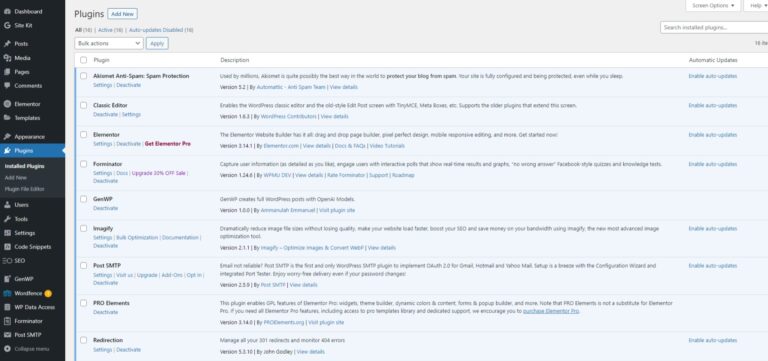WordPress is one of the world’s most popular content management systems (CMS), powering millions of websites. With its extensive plugin ecosystem, WordPress allows users to add functionality and customize their websites easily. However, this flexibility also introduces potential security risks. This article will explore security best practices for WordPress plugins to help you protect your website from vulnerabilities and ensure a safe online presence.
Understanding the Importance of Plugin Security
Plugins are an integral part of the WordPress ecosystem, providing additional features and functionality to enhance your website. However, poorly coded or outdated plugins can become a gateway for hackers to exploit vulnerabilities and gain unauthorized access to your site. Therefore, it is crucial to prioritize plugin security to safeguard your website and protect sensitive data.
Keeping Plugins Updated
Regularly updating your plugins is one of the simplest yet most effective ways to enhance security. Developers often release updates that address security vulnerabilities and patch any weaknesses in their code. Keeping your plugins up-to-date ensures you have the latest security patches installed on your website.
To update your plugins in WordPress, follow these steps:
- Log in to your WordPress dashboard.
- Navigate to the “Plugins” section.
- Check for any available updates under the “Updates” tab.
- Select the plugins you want to update and click the “Update Plugins” button.
Choosing Reliable Plugins
When selecting plugins for your WordPress website, choosing reliable ones from reputable sources is essential. Stick with plugins with a good track record of regular updates and positive user reviews. Additionally, consider checking if the plugin developer has an active support forum or community where users can report issues or ask questions.
Before installing a plugin, ask yourself these questions:
- Is this plugin regularly updated?
- Does it have positive reviews from other users?
- Is there an active support system in place?
You can minimize the risk of installing plugins with security vulnerabilities by conducting thorough research and due diligence.
Removing Unused Plugins
Unused plugins can pose a significant security risk to your website. Even if you are not actively using a plugin, hackers can still exploit it if it contains vulnerabilities. Therefore, it is crucial to regularly review your installed plugins and remove any that are no longer needed.
To remove unused plugins in WordPress, follow these steps:
- Log in to your WordPress dashboard.
- Navigate to the “Plugins” section.
- Identify the plugins that are no longer in use.
- Deactivate and delete those plugins by clicking on the respective options.
Removing unused plugins reduces the potential attack surface and makes your website more secure.
Implementing Secure Coding Practices
Developers play a critical role in ensuring the security of WordPress plugins. By following secure coding practices, they can minimize vulnerabilities and protect users’ websites from threats. Let’s explore some essential secure coding practices for WordPress plugin development.
Sanitizing User Input
User input is one of the most common sources of security vulnerabilities in web applications. By sanitizing user input, developers can prevent malicious code from being executed on their websites. Sanitization involves validating and cleaning user input before processing or storing it.
Developers can use functions like sanitize_text_field() or esc_html() to sanitize user input in their WordPress plugins. These functions remove any potentially harmful code or characters from user-submitted data, ensuring its safety before further processing.
Escaping Output
Escaping output is another crucial practice for preventing cross-site scripting (XSS) attacks. XSS attacks occur when an attacker injects malicious scripts into a website’s output, which then gets executed by unsuspecting users’ browsers.
To escape output properly, developers should use functions like esc_html() or esc_attr() when displaying user-generated content. These functions encode special characters and prevent them from being interpreted as code, effectively neutralizing potential XSS vulnerabilities.
Implementing Role-Based Access Control
Role-based access control (RBAC) is a security model that restricts access to certain functionalities based on users’ roles and permissions. By implementing RBAC in WordPress plugins, developers can ensure that only authorized users can access sensitive features or data.
WordPress provides built-in functions like current_user_can() and add_cap() to manage user roles and capabilities. Developers can leverage these functions to enforce RBAC in their plugins, allowing administrators to define granular access controls for different user roles.
Securing Plugin Configuration
Properly securing the configuration of your WordPress plugins is crucial for maintaining a secure website. Let’s explore some best practices for securing plugin configurations.
Using Strong Authentication Mechanisms
Authentication is the process of verifying the identity of users before granting them access to protected resources. When developing WordPress plugins, it is essential to use robust authentication mechanisms to prevent unauthorized access.
Developers should avoid using weak authentication methods like simple passwords or storing passwords in plain text. Instead, they should utilize secure authentication protocols like OAuth or implement two-factor authentication (2FA) for an added layer of security.
Encrypting Sensitive Data
Plugins often handle sensitive data such as user credentials or API keys. To protect this information from unauthorized access, developers should encrypt sensitive data before storing it in the database or transmitting it over the network.
WordPress provides functions like wp_hash_password() and wp_encrypt() that developers can use to encrypt sensitive data securely. By encrypting sensitive information, developers ensure that even if an attacker gains access to the data, it remains unreadable without the decryption key.
Limiting Plugin File Permissions
File permissions determine who can read, write, or execute files on a server. Setting appropriate file permissions for your WordPress plugins is crucial for preventing unauthorized modifications or access.
Developers should ensure that plugin files have the minimum necessary permissions required for their intended functionality. By setting restrictive file permissions, they limit the potential damage caused by an attacker who gains access to the server.
Conclusion
Security should be a top priority when using WordPress plugins to ensure the safety of your website and protect sensitive data. You can significantly reduce the risk of security vulnerabilities by following best practices such as keeping plugins updated, choosing reliable plugins, implementing secure coding practices, and securing plugin configurations.
Remember to regularly update your plugins, remove unused ones, and choose reputable sources for plugin installation. Additionally, developers should follow secure coding practices like sanitizing user input, escaping output and implementing role-based access control.
By adopting these security best practices for WordPress plugins, you can create a robust and secure online presence while enjoying WordPress’s flexibility and functionality.


